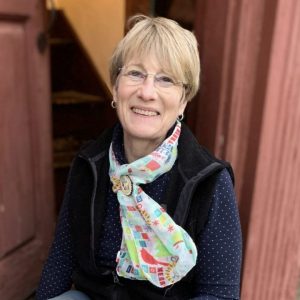November 4, 2013Â
7-8:30PM
South Shore Hospital
Emerson Building 2nd floor – Snell Conference Room
Professor David Jones, M.D., Ph.D.;
A. Bernard Ackerman Professor of the Culture of Medicine, Harvard University
Doctor Suniti Nimbkar, M.D. FACS
Medical Director of the Breast Care Center
Clinical Instructor, Harvard Medical School
Sponsored by the Abigail Adams Historical Society
In partnership with Dana-Farber/Brigham and Women’s Cancer Center
in clinical affiliation with South Shore Hospital
 In early July, 1811, Abigail Adams Smith, the daughter of Abigail and John Adams, known as “Nabbyâ€, traveled to Boston to consult with physicians about her body. She had noticed alarming changes in her right breast. She sought medical advice in Boston, near her parents. She consulted with Doctors in Boston, but also chose to consult the friend of her father, Doctor Benjamin Rush of Philadelphia. Nabby wrote to him in early September 1811. Below are excerpts from her letter:
–Abigail Adams Smith [Nabby] to Benjamin Rush,   Quincy [12] Sept[embe]r 1811
“…about May 1810 I first perceived a hardness in my right Breast just above the nipple which occasioned me an uneasy sensation, like a burning some times an itching & at time a deep darting pain through the Breast, but without any discolouration at all. it has continued to Contract and the Breast has become much smaller than it was. the tumor appears now about the size of a Cap, and does not appear to adhere but it be loose…â€
“I applied to a Physician and he recommended me to apply a Plaister of the cicuta
… I have also taken a considerable of cicuta in Pills, but I thought they produced a heaviness in my head…â€
“I have consulted several Physicians upon the Subject they have all advised me not to make any outward application to it… Still I am uneasy upon the Subject—for I think I observe it becoming harder and a little redness at times on the skin…â€
“Dr Warren who has seen it told me that in its present state he would not advise me to do anything for it…â€
Doctor Rush chose to reply to his old friend, Abigail’s father, John Adams, rather than writing to Abigail herself about such a sensitive topic. Below are excerpts from Rush’s letter to John Adams:
–Benjamin Rush to John Adams, September 20, 1811
“I shall begin my letter by replying to your daughter…After the experience of more than 50 years in cases similar to hers, I must protest ag[ain]st: all local applications, and internal medicines for her relief…â€
“From her account of the moving state of the tumor it is now in a proper situation for the operation. Should she waits ’till it supperates, or even inflames much, it may be too late. The pain of the operation is much less than her fears represent…â€
“I repeat again—let there be no delay in flying to the knife. Her time of life—calls for expedition in this business, for tumors such as hers tend much more rapidly to cancers after 45.â€
For an excellent account of Abigail’s illness and treatment, see Portia: the World Of Abigail Adams by Edith Gelles, chapter 9. See also Bathsheba’s Breast: Women, Cancer & History by James Olson
After Nabby’s radical mastectomy in 1811, John Adams wrote to Dr. Rush, the most renown physician in America at the time.
“Oh! that a vaccine Inoculation could be discovered for this opprobrium of
Philosophy and Mi[. . .]. The Cancer, This Physical [disgrow] of human Nature!â€
            — John Adams to Benjamin Rush, October 13th,  1811
Nabby healed enough to return to her home in New York in early 1812, but she was not cured. She would grow steadily worse, until it was clear that the cancer had returned with a vengeance. She traveled to her parents’ home in Quincy in the early summer, 1813.  She would die in July, 1813. Abigail was crushed by the grief of her death. She would write pitiful letters over the next several months. Here are excerpts from a few of those letters:
“She has always been my closest companion.â€
      — Abigail Adams to John Quincy Adams, April 10,h  1810
“The wound which has lacerated my Bosom cannot be healed. The broken Heart may be bound up; and religion teach submission and Silence, even under the anguish of the Heart, but it can not cure it. The unbidden sigh will rise. And the bitter tear flow long after the Tomb is closed.â€
      — Abigail Adams to John Quincy Adams, October 22nd   1813
“I that we are all well, except your Sister Smith, who has had a very sick winter, she has so far recovered, as I hope, to be upon her journey here again, John has undertaken to get her here at her most earnest request. I fear it will be, to be laid by her Ancestors. Such are her complaints; that I fear I shall have one of the distressing and trying scenes of my Life to go through To heaven I submit, trusting that as my trials are, so will my strength be—“
      — Abigail Adams to John Quincy Adams, July 14th,  1813
“To me the loss is irreparableâ€
— Abigail Adams to John Quincy Adams, September 13th  1813
“Bitter is the loss of a sweet Infant but now much more increased are the pangs which rent the heart of a Mother, when called to part with the Head of a family, in the midst of her Days, and usefulness? Endorsed by a thousand strong ties?â€
      — Abigail Adams to John Quincy Adams, December 6th 1813


